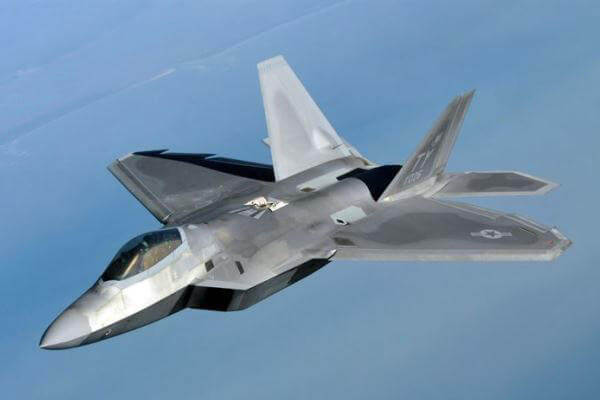The U.S. Air Force is launching a new air-supremacy effort designed to identify and develop next-generation technologies to maintain America's air dominance through 2030 at the same time the future of stealth is being questioned.
The service has stood up teams to experiment and conduct technology demonstrations to identify innovations that will guide the service and its platforms into future in which the Air Force expects to face more threats from advanced militaries like China or North Korea, Lt. Gen. Ellen Pawlikowski, military deputy for Air Force acquisition, told Military.com.
"We are going to be facing adversaries that are as modern as we are if not more so. This provides us the opportunity to leverage the entire world market of technology development through our collaborative activity with our allies," she said.
The effort, which includes work with the Air Force Research Laboratory and the Pentagon's research arm, DARPA, is looking at a wide range of future applications including hypersonics, stealth, advanced sensors, cyber technologies, drones, space systems and directed energy weapons, Pawlikowski said.
"We're taking a more enterprising look at understanding and exploring the capabilities we are going to need in the future," she said. "It is not just looking at a next-generation fighter but looking at these issues in the context of leveraging all of the capabilities that can accomplish that."
Overall, the new Air Force initiative plans to use a lot of modeling and simulations to assess and verify the validity of new or emerging technologies, Pawlikowski said.
When it comes to hypersonic flight, Pawlikowski emphasized that the service will not only explore hypersonic weapons but also hypersonic aircraft designed to carry and deliver the weapons.
In addition, Pawlikowski said the effort will look to defeat the rapidly improving air defense systems. Many experts and analysts have made the point that stealth or low-observable technologies are less effective as faster computers processors, sensors and radar can jump between multiple frequencies and help locate stealth aircraft at increasingly longer distances.
Pawlikowski said stealth technologies will continue to evolve as a way to meet these emerging threats from more advanced air-defense systems. She did not specifically reference the Air Force's new Long Rang Strike Bomber, or LRS-B, slated to enter service in the 2020's – but she did say stealth applications are evolving far beyond their original or initial configurations.
"Air defense technology has matured and is now able to counter some of the aspects of stealth. This is part of what has to happen as we continue to evolve stealth technology. Stealth is not an on and off thing. The stealth aircraft that we have in development today are very different than the original stealth that we talked about," Pawlikowski said.
Not much information about the LRS-B is available publically, however Pawlikowski did say the service plans to award a developmental deal for the platform later this year and plans to ultimately acquire between 80-to-100 bombers. Air Force officials have said the aircraft is slated to cost roughly $550 million each.
Despite the suggestion that stealth technology will benefit from future innovations, Pawlikowski emphasized that stealth by itself is not necessarily the sole answer to the evolving or maturing threats presented by modern air defenses.
"We can't count on stealth to do everything for us. Stealth combined with other attributes that will allow us to deal with that threat. Speed and stealth are extremely important but also they don't stand alone because when you are talking about air superiority it boils down to being able to act and react more quickly than you adversary can," Pawlikowski said.
Pawlikowski's stance on stealth's future was not too far off those of Chief of Naval Operations, Adm. Jonathan Greenert, who suggested in public comments that stealth technology may be losing its effectiveness in today's modern technological environment.
"You know that stealth may be over-rated," Greenert said during a speed at the Office of Naval Research Naval Future Force Science and Technology Expo, Washington D.C. "I don't want to necessarily say that it's over but let's face it, if something moves fast through the air and disrupts molecules in the air and puts out heat – I don't care how cool the engine can be – it's going to be detectable."
Greenert made these comments in the context of a discussion about the F/A-XX program designed to replace the F/A-18, however some analysts have wondered publically about the Navy's level of enthusiasm for the stealth carrier variant of the F-35, the F-35C. However, the Navy has expressed great support for the F-35C and highlighted its first-ever historic landing on an aircraft carrier in November of last year.
One analyst argued that even it stealth is less effective than it may have been several decades ago in light of global technological progress -- it is by no means irrelevant and worthy of further pursuit.
"Just because potential enemies are developing ways to detect low observable aircraft does not mean you should stop trying to avoid detection. At the end of the day it is a good thing to be detected later rather than earlier," Richard Aboulafia, vice president of analysis at the Teal Group, a Virginia-based consultancy, told Military.com.
Aboulafia also agreed with Pawlikowski when it comes to additional attributes assisting stealth or low-observable technology.
"It is an endless battle between offense and defense. Maybe there is something to be said for combat air performance on top of stealth. That was what the F-22 was -- stealth plus great kinematics, speed and lethality."
-- Kris Osborn can be reached at kris.osborn@military.com






























